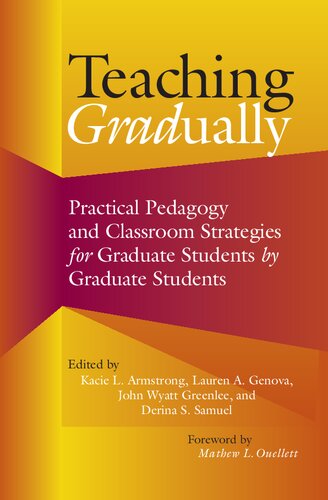

Most ebook files are in PDF format, so you can easily read them using various software such as Foxit Reader or directly on the Google Chrome browser.
Some ebook files are released by publishers in other formats such as .awz, .mobi, .epub, .fb2, etc. You may need to install specific software to read these formats on mobile/PC, such as Calibre.
Please read the tutorial at this link: https://ebookbell.com/faq
We offer FREE conversion to the popular formats you request; however, this may take some time. Therefore, right after payment, please email us, and we will try to provide the service as quickly as possible.
For some exceptional file formats or broken links (if any), please refrain from opening any disputes. Instead, email us first, and we will try to assist within a maximum of 6 hours.
EbookBell Team

4.0
86 reviewsTeaching Gradually is a guide for anyone new to teaching and learning in higher education. Written for graduate student instructors, by graduate students with substantive teaching experience, this resource is among the first of its kind to speak to graduate students as comrades-in-arms with voices from alongside them in the trenches, rather than from far behind the lines. Each author featured in this book was a graduate student at the time they wrote their contribution. Consequently, the following chapters give scope to a newer, diverse generation of educators who are closer in experience and professional age to the book’s intended audience. The tools, methods, and ideas discussed here are ones that the authors have found most useful in teaching today’s students. Each chapter offers a variety of strategies for successful classroom practices that are often not explicitly covered in graduate training.
Overall, this book consists of 42 chapters written by 51 authors who speak from a vast array of backgrounds and viewpoints, and who represent a broad spectrum of experience spanning small, large, public, and private institutions of higher education. Each chapter offers targeted advice that speaks to the learning curve inherent to early-career teaching, while presenting tangible strategies that readers can leverage to address the dynamic professional landscape they inhabit. The contributors’ stories and reflections provide the context to build the reader’s confidence in trying new approaches in their his or her teaching.
This book covers a wide range of topics designed to appeal to graduate student instructors across disciplines, from those teaching discussion sections, to those managing studio classes and lab sessions, to those serving as the instructor of record for their own course. Despite the medley of content, two common threads run throughout this volume: a strong focus on diversity and inclusion, and an acknowledgment of the increasing shift to online teaching.
As a result of engaging with Teaching Gradually, readers will be able to: